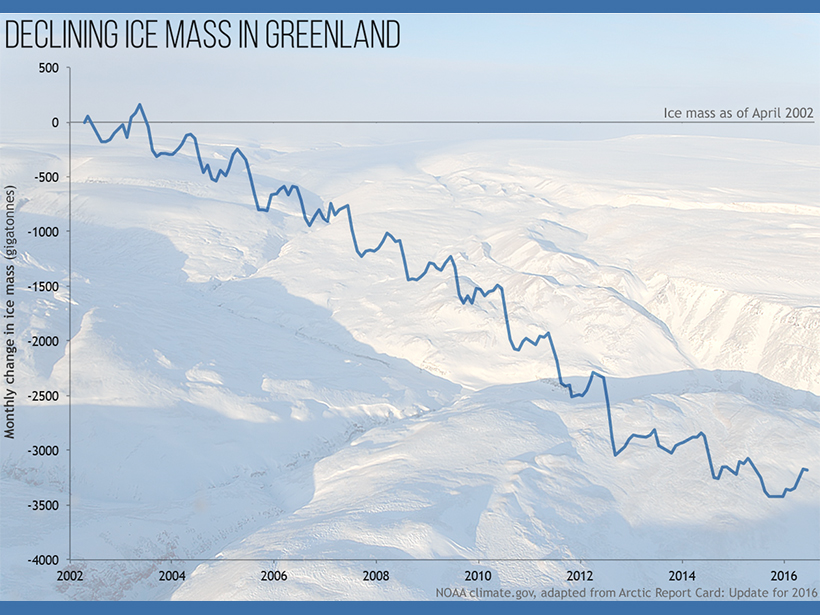High temperatures have shattered records in the Arctic in 2016, and warming continues to bring stark changes to the region. So states the most recent annual Arctic Report Card, released yesterday at a briefing at the American Geophysical Union’s Fall Meeting in San Francisco, Calif.
The average annual air temperature over land areas in the Arctic region this year reached its highest point in the observational record, a 3.5°C increase since 1900, according to the peer-reviewed report card issued by the U.S. National Oceanic and Atmospheric Administration (NOAA). This is NOAA’s 11th Arctic report card, and this year it represents the work of 61 scientists from 11 countries.
The report card also found record low spring snow cover in the North American Arctic and record low sea ice. Among other findings, the Greenland ice sheet continued to lose mass in 2016, as it has since satellite-based measurements began in 2002; sea surface temperature in August was 5°C above the 1982–2010 average in the Barents and Chukchi seas and off of Greenland’s east and west coasts; and increased Arctic Ocean productivity was prompted by springtime melting and retreating sea ice that allowed more sunlight to reach upper layers of the ocean.
Winter Warmth Stalled Ice Growth
The extraordinary, sustained Arctic warmth and ice decline go hand in hand, NOAA Arctic Research Program director Jeremy Mathis told Eos. “Because warming has been sustained into the winter months, the system has not had a chance to reset [and] the ice is not able to regrow to the extent that it has in previous years,” he said.
“The concern is that we are moving into a new regime in the Arctic.”
“I think that will set us up in the summer of 2017 and beyond to be even more vulnerable to large-scale melt events than we have been in the past,” added Mathis, who presented the report card’s findings at the briefing.
The region may even have crossed a threshold, Mathis suggested. “The concern is that we are moving into a new regime in the Arctic. The environment is going to look very different a few years from now than it did even a few years ago, and that is going to present both challenges and opportunities.”
NOAA yesterday also released the 3.5-minute video below summarizing the report card’s findings.

The Arctic Is “Shouting Change”
When NOAA began issuing annual Arctic report cards more than a decade ago, “you had to listen closely, because the Arctic was whispering change. Now it’s not whispering anymore,” said Donald Perovich, research geophysicist and adjunct professor of engineering at the Thayer School of Engineering at Dartmouth College in Hanover, N.H., a report coauthor who spoke at the briefing. He said the Arctic now is “shouting change.”
Report coauthor Marco Tedesco, a research professor at Columbia University’s Lamont-Doherty Earth Observatory in Palisades, N.Y., told Eos that he is fascinated studying the changes in the Arctic but said that he considers them worrisome and “likely irreversible.” He said that he hopes scientific studies can help lead to sustainable management of the region’s natural resources.
Developing Adaptation Strategies
Mathis said a key challenge is providing Arctic residents with information and support to help ensure the safety and sustainability of communities directly affected by the changes. Greater opportunities brought on by warming for resource development, commercial shipping, and tourism may provide some benefits for local communities and others, he suggested.
The new report card lays the scientific background for “responsible adaptation strategies,” Mathis said, “as the Arctic environment goes through what’s going to be a very rapid transition.”
—Randy Showstack, Staff Writer
Citation:
Showstack, R. (2016), 2016 Arctic Report Card highlights dramatic changes in region, Eos, 97, https://doi.org/10.1029/2016EO065085. Published on 15 December 2016.
Text © 2016. The authors. CC BY-NC-ND 3.0
Except where otherwise noted, images are subject to copyright. Any reuse without express permission from the copyright owner is prohibited.

